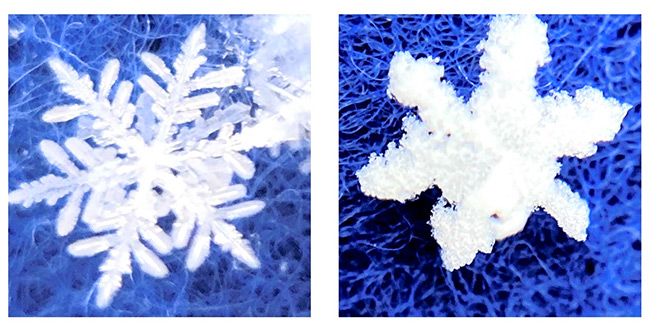Global warming could transform Hokkaido’s iconic powdered snow into the wet flakes found on Japan’s main island of Honshu, a study showed.
Researchers from Hokkaido University and the Japan Meteorological Agency’s Meteorological Research Institute studied how characteristics of snow particles in Hokkaido will change if the average global temperature rises four degrees above pre-industrial levels.
Currently, ice particles in the atmosphere tend to take in surrounding water vapors and grow into crystals that resemble columns, needles, plates and dendrites, which create the smooth and light snow characteristic of Hokkaido.
 Three images from the left show snow crystals that resemble a needle, a plate and a dendrite, which are often found in the snow of Hokkaido. The other two images show a rimed crystal, second from right, and graupel, which are often found in the snow of Honshu. (Provided by the Hokkaido Weather Technology Center and Hokkaido University’s Laboratory of Meteorology)
Three images from the left show snow crystals that resemble a needle, a plate and a dendrite, which are often found in the snow of Hokkaido. The other two images show a rimed crystal, second from right, and graupel, which are often found in the snow of Honshu. (Provided by the Hokkaido Weather Technology Center and Hokkaido University’s Laboratory of Meteorology)
But the team’s numerical simulations showed that if global warming increased, the percentage of rimed crystals and graupel, or soft hail, which are formed when surrounding water droplets adhere to ice particles, would increase.
Researchers said rimed crystals, which are attached with cloud particles, and graupel characterize the snow that often falls in the Sea of Japan side of the Hokuriku to Tohoku regions of the Honshu main island.
“While the results can be somewhat expected, our study laid the groundwork to discuss issues based on scientific grounds,” said Yousuke Sato, an associate professor of meteorology at Hokkaido University, who is on the research team.
“Hokkaido is popular among winter sports enthusiasts for its fluffy and light snow, but we need to think about what to do with tourism if the quality of snow changes,” he said. “If the snow becomes heavier, it can substantially impact people’s daily lives, such as snow clearance.”
The study results are also expected to contribute to avalanche probability forecasts.
Conventional simulations for weather forecasting and climate change prediction have largely focused on the amounts of snowfall or snow accumulation.
It was not known how characteristics of snow particles, such as shapes and densities, will change with global warming.
The research team developed an original method that can calculate what shapes snow particles tend to grow into at different temperatures and humidity levels.
It was incorporated into a meteorological model that simulates atmospheric flows, cloud movements and other factors.
The numerical simulations were conducted using a supercomputer at Hokkaido University.
The research results were published in a journal of the American Meteorological Society.


AloJapan.com